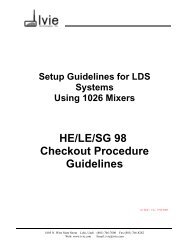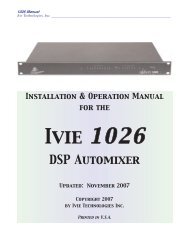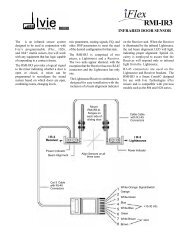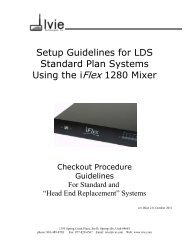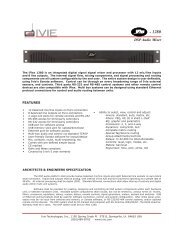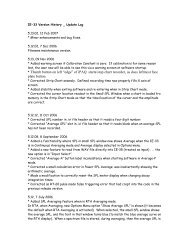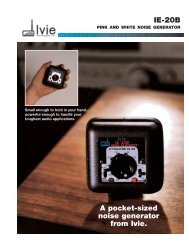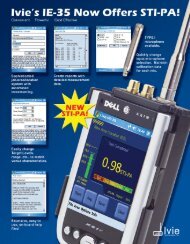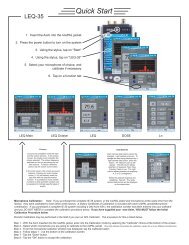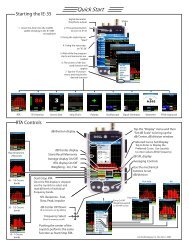You also want an ePaper? Increase the reach of your titles
YUMPU automatically turns print PDFs into web optimized ePapers that Google loves.
NIC and (F)STC Measurements<br />
NIC Measurements<br />
page 20<br />
<strong>Ivie</strong> <strong>IE</strong>-<strong>33</strong> & <strong>IE</strong>-<strong>35</strong> <strong>Manual</strong><br />
Sound transmission field testing of operable walls and field partitions is almost exclusively done using ASTM<br />
E<strong>33</strong>6 as the standard. The <strong>IE</strong>-<strong>33</strong> and <strong>IE</strong>-<strong>35</strong> are capable of making Noise Isolation Class (NIC) measurements.<br />
NIC measurements are normally specified rather than Field Sound Transmission Class (F)STC measurements<br />
because they are faster, easier, and therefore, less expensive to make. Field Sound Transmission Class<br />
({F}STC) measurements require RT60 information for the calculation, as well as receiving room absorption in all<br />
sixteen 1/3 octave bands of interest. Both the <strong>IE</strong>-<strong>33</strong> and the <strong>IE</strong>-<strong>35</strong> are capable of making RT60 measurements<br />
(if the optional RT60 software module is purchased) as well as measuring receiving room absorption in the<br />
required sixteen 1/3 octave bands. However, since RT60 measurement capability is an option, not a standard<br />
feature, <strong>Ivie</strong> has chosen not to integrate (F)STC measurement measurement capability into the <strong>IE</strong>-<strong>33</strong>, or <strong>IE</strong>-<strong>35</strong>,<br />
measurement suite. The following instructions are therefore limited to the theory of NIC measurements and<br />
making NIC measurements.<br />
NIC is a single-number acoustical rating of sound isolation between two different spaces separated by a sound<br />
barrier. A typical measurement example would be determining the sound isolation provided by a wall or movable<br />
partition separating two rooms. To make the measurement, an omni-directional sound source would be<br />
placed in the Source Room to energize it with pink noise. Averaged (power averaged), 1/3 octave RTA spectrum<br />
measurements would then be made on both sides of the wall (Source Room and Receiving Room) and<br />
each room average would be stored to separate memory locations. The NIC calculation would begin as the<br />
stored spectrum of the Receiving room is subtracted from the stored spectrum of the Source Room to create a<br />
Transmission Loss (TL) curve.<br />
The NIC rating would then be determined by comparing and shifting the TL curve relative to the standard NIC<br />
contour such that the TL curve is never more than 8 dB below the NIC contour in any 1/3 octave band; and the<br />
sum of the deficiencies below the contour over the 16, 1/3 bands, does not exceed 32 dB. Once the TL curve is<br />
shifted to meet these criteria, the NIC rating is determined by the value of the NIC contour at 500 Hz. Once the<br />
Source Room and Receiving Room curves are stored, the curve fitting and NIC calculation are all done automatically<br />
by the <strong>IE</strong>-<strong>33</strong>, or <strong>IE</strong>-<strong>35</strong>. Only a few taps of the stylus are required to complete the measurement and display<br />
the results.<br />
The step-by-step process for making an NIC measurement is demonstrated by the illustrations on the opposite<br />
page. Note: Of particular interest in NIC measurements is the requirement for power averaged data. The <strong>IE</strong>-<br />
<strong>33</strong> and <strong>IE</strong>-<strong>35</strong> “default” operating mode is “Arithmetic Average,” so “Power Average” will need to be selected.<br />
Real Time NIC Measurements<br />
This is a very useful diagnostic tool offering, unique to <strong>Ivie</strong> instrumentation. This mode allows the user to compare<br />
the stored average curve in the Source Room to real time data in the Receive Room, thus providing a running<br />
calculation of NIC in real time. While in the Receive Room, the microphone can be moved to any position<br />
around the sound barrier to find "sound leaks", weak isolation areas, strong isolation spots etc. Because the<br />
NIC curve and calculated number are continuously updated in real time, it is easy to quickly compare different<br />
areas, thereby determining deficiencies relative to location.



